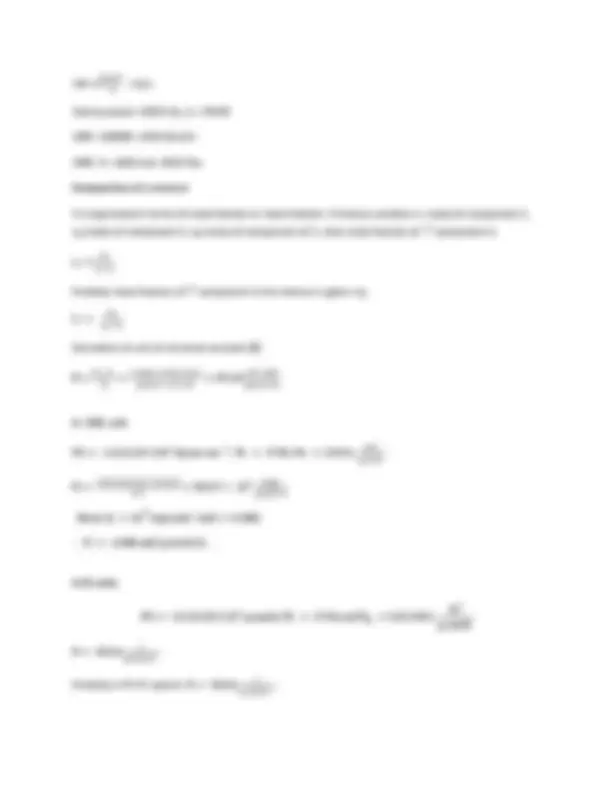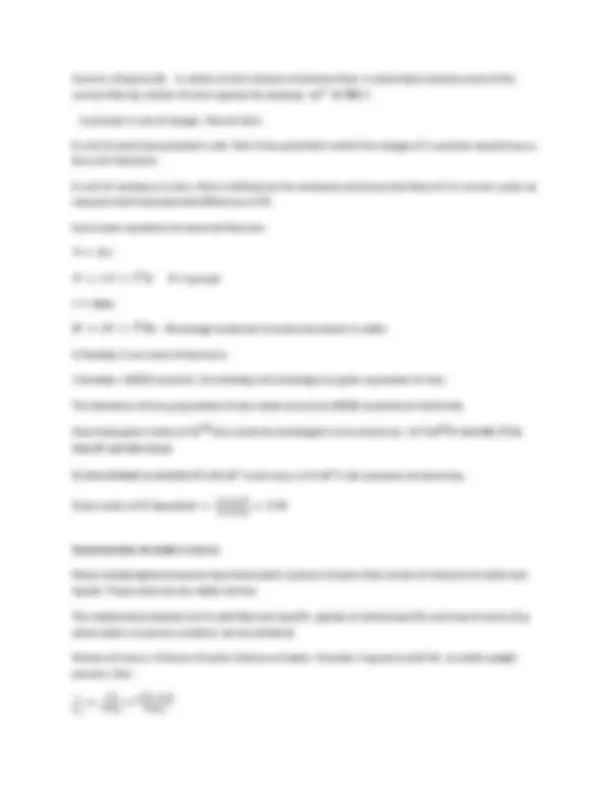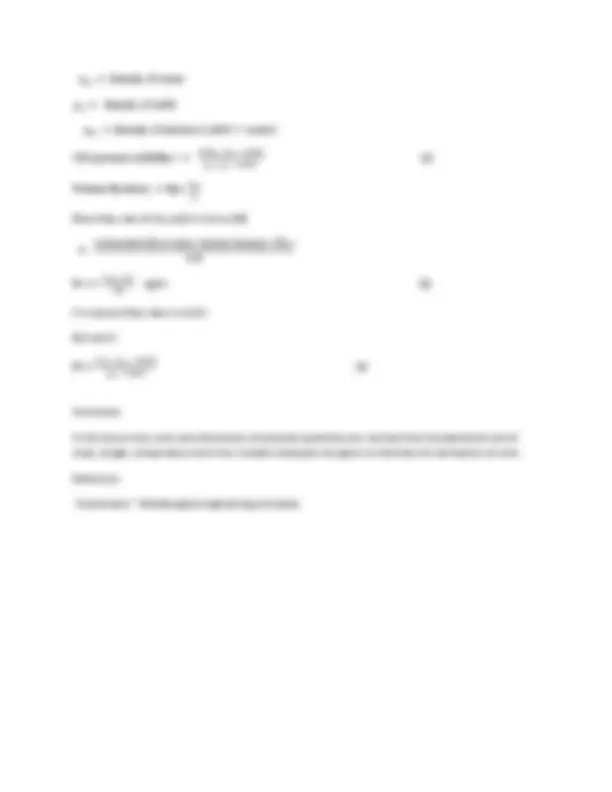





Study with the several resources on Docsity

Earn points by helping other students or get them with a premium plan


Prepare for your exams
Study with the several resources on Docsity

Earn points to download
Earn points by helping other students or get them with a premium plan
Community
Ask the community for help and clear up your study doubts
Discover the best universities in your country according to Docsity users
Free resources
Download our free guides on studying techniques, anxiety management strategies, and thesis advice from Docsity tutors
This lecture explores the concept of units and dimensions in metallurgical engineering, focusing on standard units of measurement, derived units, and the composition of mixtures. It also covers the derivation of units for fundamental constants such as r, and electrical units like current and potential. Key topics include force, energy, power, and concentration of solids in slurries.
Typology: Study notes
1 / 5

This page cannot be seen from the preview
Don't miss anything!




Lecture 2:Measurement of Quantities Contents Preamble Standard units of measurement Derived units and quantities Composition of a mixture Derivation of units of universal constant Electrical units Concentration of solids in slurry Conclusion References Key words: unit and dimension, fundamental units, power, pressure Preamble The material balance shows the weights and analysis of input and output materials and the calculated inputs and outputs of each of the important elements and compounds. This accounting serves as a check on plant data in that the various totals of inputs and output should be equal. This lecture discusses the different ways of expression of measured quantities. It is felt that many a times the students have problems in unit and dimensions and to converting one unit to another. Standard units of measurement The adoption of standards has varied greatly as regards unit in different parts of the world. The following table lists some of the commonly used set of fundamental units from which all other units can be derived Quantity Absolute units FPS CGS MKS SI
Engg. Units English Mass Pound gram kg kg Slug (lb) (g) Length ft cm m m ft Time sec sec sec s sec Amount of substance Lb. mole g.mole kg mole mole Lb. mole Temperature o^ F o^ C o^ k(ork) k o^ F
FPS stands for feet, pound and second. It is british system
tension of MKS system
erived units and quantities derived from other physical quantities are called derived quantities.
example area, volume etc.
celeration. ୫ୱଶ
CGS stands for centimeter, gram and second MKS stands for meter, kilogram and second SI stands for international system of units. Ex
Physical quantities which can be Derived units: The units of physical quantities which can be expressed in terms of fundamental units, for
Lets us derive (i) unit of force Force =mass x ac
In SI unit force ൌ ୩^ ൌ 1N (Newton).
In CGS unit forc e = (^) C୫ୱଶ =
exp ewton( N)
dyne
In MKS unit force is ensed in N
In FPS systems force is Lୠ୲ୱ =1poundal
(ii) Energy =mu^2 we can substitute the units of m and u to derive unit of energy.
In SI system E ൌ kg ୫ଶୱଶ ൌ 1Joule.
In CGS system E ൌ g C୫ଶୱଶ ൌ 1 er
rgs. Lb ft ଶ^ /s ଶ^ ൌ ft poundal. 1British thermal unit (Btu) =778 ft. Lbf =1054.2 Joule = 252 cal 1kcal = 1000cal.=3.968 Btu (iii) power (watts or W).
g.
1goule = 107 e
In FPS system E ൌ.
Current =Ampere (A In solids current consists of electron flow. In electrolyte solutios.most of the
e: flow of 1A/s. s a
as the resistance which ermits flow of 1 A current under an imposed electrical potential difference of 1V. s of electrical flow are:
ൌ t P ൌ I 2 Rt. W=energy measured in joules and power in watts Farada is one mole of electrons. faraday 96500 coulomb. One raday will discharge one gram equivalent of ions. The liberation of o bs of electricity
ସ ସ d ൌ ల
1coulomb is unit of charg SI unit of electrical potential is volt. Volt is the potential in which the charge of 1 coulomb experience force of 1 Newtron. SI unit of resistance is ohm. Ohm is defined p
Some basic equation V ൌ R. I P ൌ I. V ൌ I 2 R P ൌ power t ൌ time W A y 1 = fa ne g equivalent of any metal consumes 96500 coulom How many gram moles of Al 3ions
Gram moles of Al deposite ଵ.ଵସൈଵଷൈଽହ ൌ 3.
Concentration of solids in slurry: Many metallurgical processes have feed and/or product streams that consist of mixtures of solids and lled slurries. The relationship between wt % solid (%x) and specific gravity of solid phase (Ps ) and that of slurry (P (^) m ) an be obtained:
ౣ^ ଵ
liquids. These mixtures are ca
when water is used as a medium c Volume of slurry = Volume of solid x Volume of water. Consider 1 kg slurry with %x as solids weight percent, then
ൌ (^) ଵ%୶ (^) ౩ ሺଵି%୶ଵ (^) ౭^ ሻ
ρ୵ ൌ density of water ρୱ ൌ density of solid ty of mixture ሺsolid waterሻ
ሺWt percent solidሻ% x ଵౣ ౩ሺ^ ሺౣି (^) ౩ି ଵଵ ሻ^ ሻ
ρ୫ ൌ densi ൌ (1)
Vo lume % slurry ൌ % x ౣ (^) ౩
ass flow rate of dry solid in slurry (M) ୴୭୪୳୫ୣ୲୰୧ୡ f୪୭୵ ୰ୟ୲ୣ ൈୱ୪୳୰୰୷ ୢୣ ୳୬୲୷ ൈ% ୶ ଵ
M ൌൈ F ౣଵ^ %୶ kg/hr
F is volume flow rate in m3/h By1 and 2
M ൌ F ሺ^ ౩^ ሺౣି (^) ౩ି ଵ^ ଵ ሻ^ ሻ
r.
Conclusion nsions of physical quantities are derived from fundamental unit of time. Suitable examples are given to illustrate the derivation of units.
Schuhmann” Me
In this lecture the units and dime mass, length, temperature and Reference: tallurgical engineering principles